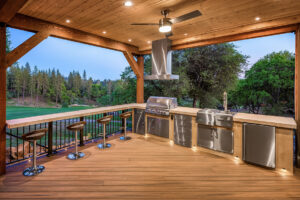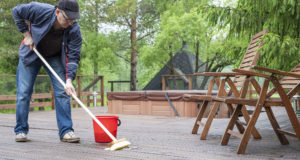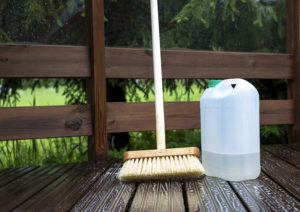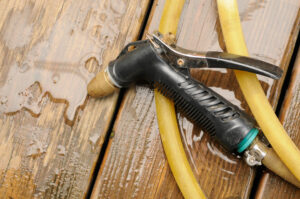How to Clean Your Deck the Right Way
By Dave KileDeck cleaning time is here, and while many homeowners focus on scuffed baseboards, dust bunnies, and smudgy windows around the house, it’s important to also remember the deck.
If your deck surface is anything like mine, it has faced many challenges throughout the past year. This includes summer hot dogs rolled off the grill, fall leaves turned into tiny bits of grime between deck boards, and winter weather assaulting your wood or composite decking—to name a few.
Now’s the time for a refresh. We’ve got your guide to cleaning your deck the right way, just in time for warmer weather.
How to Clean Your Deck
Cleaning a deck doesn’t have to be difficult or time-consuming, but it is essential in making it last. While the steps are simple — remove anything on the deck, sweep, and clean — you will want to be sure you’re doing it right.
Deck Cleaning Solutions and Materials Needed
To prepare for your deck cleaning, gather a broom, scrub brush, bucket, garden hose, and cleaning solution.
Be sure to use cleaning products and materials that won’t harm your deck — or you. Never mix ammonia-based ingredients with bleach, which can create toxic chloramine gas, which can cause respiratory irritation.
Instead, purchase or mix a cleaning solution specially made for your wood or composite deck. Many deck cleaning products are readily available online or at local hardware stores.
What is the Best Homemade Deck Cleaner?
If you want to mix up something yourself, go for an eco-friendly solution that’s right for your deck material.
Homemade Composite Deck Cleaner
The ingredients you need for your composite deck cleaning solution are:
- 2 ½ tsp (12 ml) white vinegar or apple cider vinegar
- 1 ¼ tsp (6 ml) of baking soda
- 1 gallon (3.8 liters) of water
Important: Avoid homemade deck cleaners or brighteners when using a pressure washer or power washer. Any granular cleaner will clog the tiny nozzles on the sprayer.
Homemade Wood Deck Cleaner
The ingredients you need for your wood deck cleaning solution are:
- 1 oz (29 ml) ammonia-free liquid dish soap
- 1 5/8 cups (473 ml) rubbing alcohol
- 4 5/8 cups (1.1 liters) oxygen bleach (not chlorine bleach)
- 1 gallon (3.8 liters) water
Oxygen bleach is safe for wood decks and helps in removing mold. Avoid chlorine bleach.
What is the Best Way to Clean Decking (5 Steps)?
As mentioned, the best way to clean decking depends on whether you have wood or composite boards. However, there are five basic steps for cleaning all decks.
1. Clear Off the Deck
Remove all furniture, plants, and deck décor. Once clear, inspect the decking for warping, discoloration, and spongy boards. Replace any rotted deck boards and tighten any loose screws and fasteners.
2. Sweep the Deck Boards
Over time, debris will accumulate on top of your deck, which you need to remove as it can stain and hold in moisture. Use a putty knife or screwdriver to remove stubborn bits between the boards.
3. Pre-rinse the Deck
Use a hose to rinse any remaining loose debris off the deck. This step allows the deck cleaner to disperse more easily and work more effectively.
4. Apply Deck Cleaner
Pick a deck cleaning solution geared to the kind of deck you have (wood or composite). Read and follow the instructions on the bottle, or try a homemade deck cleaner—like the homemade cleaners in the previous section.
5. Rinse the Deck
Rinse all the decking thoroughly so you don’t leave behind a film or build-up. Hold the hose about 6-12 inches above the deck’s surface and spray a few feet in front of you. The water stream should be strong enough to wash away dirt and debris. Never use high pressure, which can damage your decking and splinter your wood.
Deck Cleaning Tips:
- Whether you’re using a homemade cleaner or a purchased one, wear gloves. Some cleaning agents can cause skin irritation.
- It’s best to dispose of leftover homemade cleaner instead of storing it. Simply make a fresh batch the next time you need it.
- Keep all cleaning solutions out of reach of children.
How to Clean a Wood Deck
To clean a wood deck, you need a deck cleaning solution, a hose, and a scrub brush. When cleaning a wooden deck, ensure that you:
1. Pre-rinse the Wood
Pre-rinsing helps soften dried cellulose fibers and allows the cleaning solution to disperse more easily.
2. Use a Stiff Bristle Brush
A long-handled brush is excellent for general cleaning. However, I highly recommend a handheld stiff bristle brush to tackle stains and remove tough dirt, mildew, or mold.
3. Reconsider Power Washing
For most wood deck maintenance, a power washer is unnecessary—a hose will do just fine for rinsing. In my many years of experience in the decking industry, I have seen them do more extensive damage more times than I can count.
4. Let the Deck Dry Before Sealing
Wet wood can take 24-48 hours to dry out thoroughly— tack on an additional 24 hours for damp or humid climates.
5. Apply a Deck Sealant
A deck sealer will protect your wood deck, mitigating future wear and damage. Try using a long-handled paint roller or sponge applicator to apply it over the deck boards. Sanding before sealing is often recommended as it smooths out any rough spots and helps the product penetrate more deeply and evenly.
How Do I Naturally Clean My Wood Deck?
To naturally clean a wood deck, try a mix of vinegar and baking soda.
There is arguably no natural duo more widely utilized than vinegar and baking soda when it comes to natural cleaners. To use them to clean wood decking, you will need:
- 1 cup vinegar (250 ml)
- 1 gallon (3.7 liters) warm water
- 4+ boxes baking soda (depending on your deck size)
Once you’ve gathered your ingredients, follow these 4 easy steps:
- Mix together the water and vinegar and apply a layer over the decking.
- Sprinkle on a layer of baking soda.
- Scrub over all the boards using a scrub brush. Add more vinegar solution if necessary.
- Rinse with water.
Have stubborn deck stains? Borate, commonly known as Borax, is also a powerful natural cleaner.
Word of Caution: In my years in the decking industry, I have had many people come to me for advice after damaging their painted decking using natural baking soda and vinegar solutions. It is quite abrasive and can scratch, loosen, or soften the paint. Therefore, it is best for bare wood or wood decking that will be refinished. For a gentler natural cleaning solution, scroll up to see our DIY wood deck cleaner recipe.
How to Clean a Composite Deck
For composite decking, be sure to use the proper cleaning agent. If you decide to use a power washer, hold the wand at least a foot above the boards, choose a fan tip, and use pressure no greater than 3100 psi.
How to Clean Composite Decking with Vinegar
You can clean a composite deck with vinegar using a jug of vinegar, a bucket of water, a mop, and a hose.
- 1 part vinegar
- 4 parts water
- a mop and bucket or a spray bottle
- a hose
- scrub brush (optional)
- Clear off your deck and sweep off any debris.
- Mix together the water and vinegar in your bucket or spray bottle. The amount you need will depend on your deck size.
- Generously apply the solution with the sprayer or mop. Consider gently using a scrub brush for any extra dirty areas.
- Leave the solution sit for 15 – 20 minutes.
- Rinse off thoroughly using a hose.
How to Clean Trex Decking

- Clear the deck’s surface and sweep off any large debris.
- Spray down with a hose to remove smaller debris and dirt.
- Gently scrub the surface with a soft bristle brush and warm soapy water. If using a cleaning solution, follow the instructions on the packaging.
- Rinse well using a hose.
Looking to get rid of hard water stains, debris stains, or mold and mildew? Visit our guide to Cleaning Trex Decking for more information.
How Do I Clean My Deck Without a Pressure Washer?
To clean a deck without a pressure washer, you will need a deck cleaning solution, a hose, and a scrub brush. A scrub brush with a handle allows you to stay upright, similar to using the nozzle of a pressure washer.
Remember: a pressure washer may be faster for rinsing, but it also comes with the danger of damaging your boards.
Cleaning may not be at the top of your list of spring activities, but it will make a significant difference in the life of your deck. It’s an easy DIY project with big benefits. A couple of hours in the fresh spring air will do you and your boards good!



